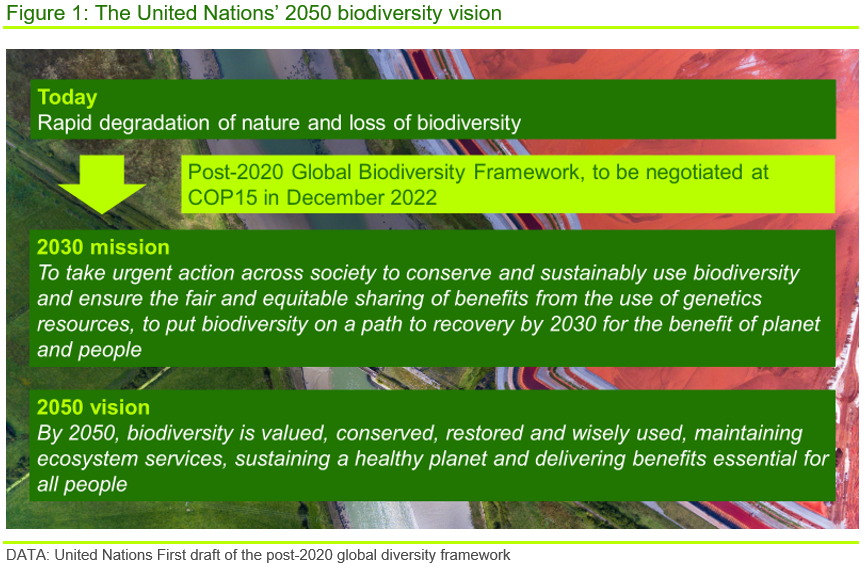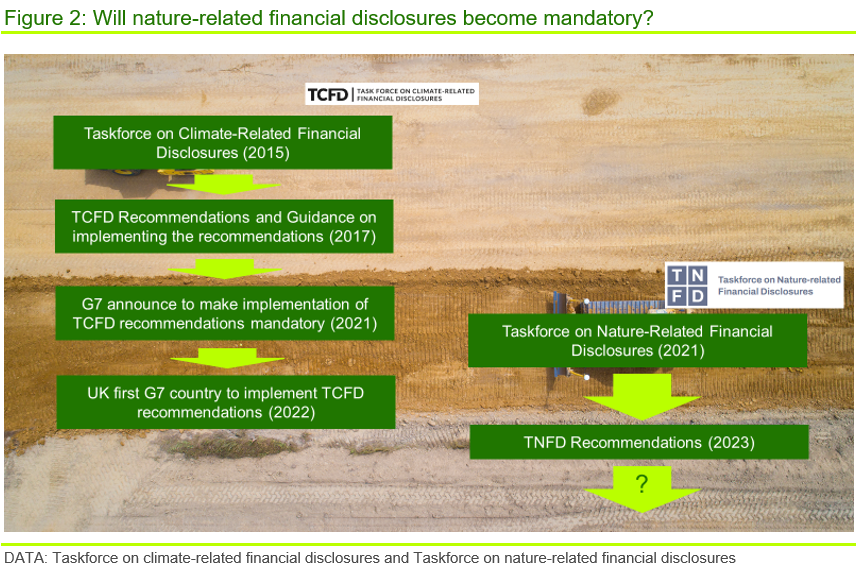Addressing climate change has arguably been the single most important global policy issue over recent years. There is now an increasing focus on the degradation of nature and loss of biodiversity. As policymakers become more serious about addressing these complex issues, businesses in the commodity markets will need to develop more detailed environmental strategies and will need to be prepared to pay more to protect the environment.
There is more to the environment than climate change
Heatwaves around the world, the upcoming COP27 in Egypt, global migration flows, the energy crisis and heightened geopolitical tensions – it appears as if every single policy debate nowadays is shaped by climate change.
However, climate change is not the only important environmental issue to be worried about. Over the last few years, we have seen an increasing focus on two other important environmental issues – the dramatic degradation of nature and loss in biodiversity. Could dealing with these two key issues be the next big thing for the commodities sector?
Nature and biodiversity add trillions to global GDP and are fundamental to human livelihoods
Addressing climate change has arguably been the single most important global policy issue over recent years. More and more countries are signing up to ambitious climate targets and actions in the form of nationally determined contributions (NDCs). The overarching objective is to achieve “net zero” by mid-century where the “net” in net zero allows for some carbon emissions as long as these are offset by carbon removal, either through high-tech solutions such as direct air capture or natural carbon sinks such as forests or mangroves. The former do not exist yet on any commercially viable scale, the latter are referred to as nature-based solutions. We will explore the role nature-based solutions can play in climate mitigation in a future Insight.
Nature and biodiversity play an important role in addressing climate change. However, the role of nature and biodiversity is not only limited to helping us achieve net zero targets. They matter in their own right.
In 2019, the OECD estimated that the ecosystem services provided by biodiversity such as crop pollination, water purification or flood protection were worth around $125–140 trillion annually – one and a half times global GDP. Moreover, a loss in nature and biodiversity would have catastrophic consequences. The World Economic Forum put biodiversity loss and ecosystem collapse as one of its top five risks in its 2020 Global Risks Report. The importance of nature and biodiversity is also seen in the UN’s Sustainable Development Goals, with no less than four of the 17 goals (clean water and sanitation, responsible consumption and production, life below water and life on land) directly linked to nature and biodiversity.
Nature and biodiversity are hugely complex issues…
Addressing issues of nature and biodiversity is a vastly more complex undertaking than climate change mitigation. For all its technological, economic, political and societal challenges, at least in principle, climate change mitigation is relatively straightforward – climate policy needs to target only one metric – carbon emissions – and societies only need to focus on one thing – reducing carbon emissions. Climate change mitigation is helped by the fact that a tonne emitted in New Zealand is the same as a tonne emitted in Canada – they have the same impact on global climate change. We also have a relatively good grasp of the relationship between carbon (or more precisely greenhouse gas) emissions and climate change, which has put us in the position to set science-based emission targets over the coming decades.
By contrast, nature and biodiversity generally have a local or regional dimension, though the biodiversity of the Amazon rainforest, for example, will have a global dimension. They might even have a seasonal dimension to them. They share this with climate change adaptation, which also has a local or regional dimension, requiring specific solutions to specific circumstances. A “one size fits all” approach does not work when it comes to addressing the decline of biodiversity or climate change adaptation.
…making it difficult to formulate simple policy objectives
It is also more complicated to measure nature and biodiversity; and it is close to impossible to map multiple methodologies and indices into one representative metric. This makes it difficult for policymakers to develop a simple, convincing narrative, and makes policy formulation difficult. Cost-benefit analysis, used to design a policy intervention, will struggle with these challenges.
It will also make it difficult to create a market for nature and biodiversity as has been possible for carbon emissions. We can trade tonnes of carbon emissions on emissions trading schemes, we can impose taxes on tonnes of emissions, we can offer offsets, we can try to introduce a carbon border adjustment mechanism. But how feasible is it to do that with nature and biodiversity? Can we create a missing market and start trading one unit of “nature” or “biodiversity”? Unlike climate change, where it should be possible to establish a global price for carbon emissions, the marginal benefit and cost of one more unit of nature or biodiversity will also vary across locations.
This makes environmental targets and regulations the most likely policy response. The European Union, for example, has ambitious environmental objectives and implemented its 8th Environment Action Programme in May 2022 as part of the European Green Deal. The programme, which covers the period up to 2030, has six priorities, from achieving net zero by 2050 to accelerating the transition to a circular economy, and protecting, preserving and restoring biodiversity. To achieve its objectives, the EU has set itself a raft of targets, among other initiatives, such as planting three billion trees, increasing the total area covered by green urban space by 3% by 2040, or restoring at least 25,000 kms of free-flowing rivers.
The UK government’s Environment Act 2021 also sets targets and introduces environmental regulations, while also mandating a net gain in biodiversity through the planning system as measured by a metric established by the UK’s environment ministry. UK developers will be forced to improve biodiversity on the development sites themselves. If this is impossible, they will need to compensate the loss of biodiversity on the development site by increasing biodiversity offsite. As a last resort, developers might be able to buy biodiversity credits from the government. Biodiversity offsets have existed in many countries for many years (e.g. in the United States since the 1970s) and are not without their challenges, particularly in emerging economies where social and political factors might be even more important for their success than environmental considerations.
That said, biodiversity offsets and the creation of biodiversity credits could in principle provide a foundation for a market-based policy to address the decline of biodiversity, which could complement targets and regulations. Watch this space for further market developments.
There are also major initiatives on the global level, with the next UN Biodiversity Conference (COP15) to be held in Canada in December 2022 after several Covid-19-related delays. It was initially meant to take place in China in early 2020. Despite the change in venue, COP15 remains under the Chinese presidency. The main objective at the event will be to adopt the post-2020 global biodiversity framework and launch its implementation. The framework establishes a mission and sets milestones for 2030 and has the overall vision of “living in harmony with nature” by 2050 – a much vaguer concept than limiting the increase in global temperature to 1.5 degrees above pre-industrial levels.

Nature and biodiversity – what are the financial market risks and opportunities?
The work of the Task force on climate-related financial disclosures (TCFD), set up in 2015, was instrumental in raising awareness of climate change issues within the financial community. In 2021, G7 leaders announced that they would make implementation of the taskforce’s recommendations mandatory. Since early 2022, the largest companies and financial institutions in the UK are required to report on climate-related risks and opportunities. Other countries are expected to follow suit.
For investors and asset managers, understanding these risks and opportunities is fundamental to their investment strategy.
In 2021, a new Taskforce on nature-related financial disclosures (TNFD) was established. Its aim is similar to that of the TCFD: “To develop and deliver a risk management and disclosure framework for organisations to report and act on evolving nature-related risks, with the ultimate aim of supporting a shift in global financial flows away from nature-negative outcomes and toward nature-positive outcomes”.
The TCFD currently has 34 members representing financial institutions, major corporates and market-service providers such as consultancies and stock exchanges. Its activities are funded by governments and philanthropic grants. The TCFD aims to launch its framework, which should enable companies and financial institutions to integrate nature into their decision-making processes in September 2023.

At a minimum, we expect that the TNFD’s work will raise awareness of nature-related risks and opportunities among the financial community. Investors will increasingly ask themselves whether a certain investment might become a stranded asset, for example because of a loss in biodiversity leading to a lack of clean water required for production, and will take a closer look at the impact of an enterprise on regional biodiversity.
A greater focus on nature will represent new challenges for commodity markets and policymakers
These developments will not only pose new challenges for businesses in the commodity markets but also for policymakers, especially in advanced countries where the issue of greater commodity self-sufficiency has gained traction in recent years. There is a growing focus on resource security as geopolitical instability has grown and global supply chains are stretched. However, despite there being obvious positives for governments, reshoring strategic value chains (such as batteries) to advanced countries could cause communities, and voters, to worry about localised environmental degradation and loss of biodiversity.
Policymakers will need to find a balance between environmental, economic and societal objectives. Many policymakers in advanced countries have not worried about trade-offs and processing has often taken place out of sight in countries perceived to be far away. We expect this to change.
The viability of future mine projects will increasingly depend on environmental factors
These developments matter particularly to commodity markets businesses. Markets and parts of the value chain have come under increasing pressure for different environmental reasons. For example, much of the attention in the steel and aluminium sectors is focused on emissions reduction, due to their scale, and the challenges and costs involved in decarbonising them. Within battery materials, much of the focus has been on responsible sourcing. Water usage, host community relations and tailings are key issues in the copper market.
Mining frequently takes place in environmentally sensitive locations, with the mining process itself (e.g. stripping land, processing and transport) and the disposal of waste (e.g. tailing, effluent streams) often having a significant adverse effect on the local environment.
It is becoming less obvious that only the most profitable mine projects are being completed. Returns to investment are not the sole determinant of the fate of each project. Mining projects have been affected by onerous environmental permitting, long and protracted community consultations, and additional investments for water, energy, and mine electrification. Nature and biodiversity will grow in importance here also. Issues other than economics are becoming increasingly influential to a project’s success.
While new projects will still go ahead, minimising the environmental impact and risks will often mean much higher capex costs. This will impact the financial viability of many new projects. Higher operating costs might also make existing activities uneconomic in the future, shortening their productive lifespan.
Businesses will need credible environmental strategies and will have to pay more to protect nature
Investors will increasingly scrutinise the climate change and environmental risks that businesses across the entire commodities value chain face, and will invest accordingly. Similarly, when making sustainable investment decisions, asset managers will increasingly look at the impact businesses have on climate change and the environment more broadly, including biodiversity. This higher level of scrutiny will raise the bar for new projects, particularly for mining companies in environmentally sensitive areas.
Businesses in the commodities sector will need to stay ahead of these developments. If recent developments around climate change are anything to go by, corporates will likely have to publish more detailed environmental strategies to go alongside credible net zero strategies; as well as sharpen their environmental objectives, strengthen internal monitoring and external reporting, and improve their governance structures. Given the rather vague nature of the challenge, this might be much more difficult to achieve for corporates than addressing climate change.
Businesses should also be ready to pay a higher price for damaging the environment or lowering biodiversity. Just like emitting carbon is becoming much more expensive due to carbon taxes or emission trading schemes, the costs for environmental damage will grow. As policymakers step up their efforts by tightening regulations and developing market-based solutions, businesses will need to be prepared to pay more to meet these regulations and might even end up having to trade “biodiversity permits” in years to come.
Find out more about our Sustainability Services.
Our reputation as an independent and impartial authority means you can rely on our data and insights to answer your big sustainability questions.
Tell me more

